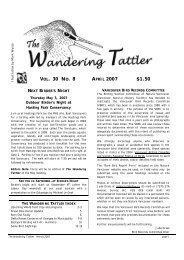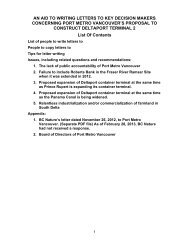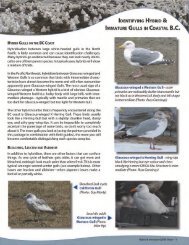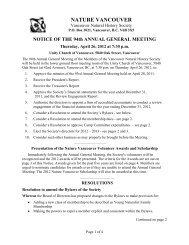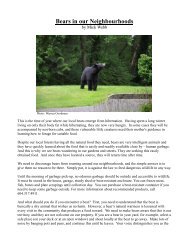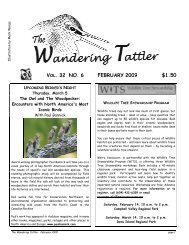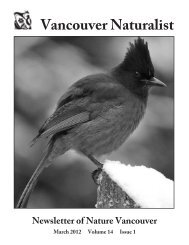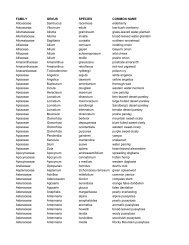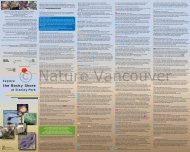Wandering Tattler - November 2011.pdf - Nature Vancouver
Wandering Tattler - November 2011.pdf - Nature Vancouver
Wandering Tattler - November 2011.pdf - Nature Vancouver
Create successful ePaper yourself
Turn your PDF publications into a flip-book with our unique Google optimized e-Paper software.
POACHER CAUGHT ATBOUNDARY BAY REGIONAL PARKEditor’s Note: This is a follow up story from the EnvironmentCanada News Release that appeared in the October 2011 WT.The version below highlights the actions of Metro <strong>Vancouver</strong>Parks Staff in catching the poacher. JFGThanks to the quick work of one of our employees, a poacherhas been caught at Boundary Bay Regional Park.Richard Mills, a Parks West Area employee, was on his regularpatrol in Boundary Bay Regional Park dyke area, when he wasalerted by a local researcher and birder who suspected thattwo hunters may be shooting Dunlin birds off the dyke.Richard quickly made a call to the provincial conservationofficer who directed Delta Police to respond. The huntersthen started to return to their vehicle and Richard asked thehunters to remain on site, as requested by the conservationofficer who was still on phone communication with Richard.Richard noticed that the hunters were carrying bags of birds.Upon arrival of the police (who turned out to be a formerMetro <strong>Vancouver</strong> employee) the hunters were found to have 63Dunlins and a Great Blue Heron in their possession. Seasonalhunting with permit is allowed at Boundary Bay but under theMigratory Birds Convention Act of 1994, there is no huntingallowed of Dunlin and Great Blue Herons. It is also prohibitedto possess carcasses of these birds without lawful excuse.Hang Jian Guo was investigated and in September 2011 wasconvicted of illegal hunting. He was sentenced to pay a fine of$10,000 towards the Environment Damages Fund. The Fund,administered by Environment Canada, was created in 1995 toprovide a mechanism for directing funds received as a resultof fines, court orders and voluntary payments for the repairof the actual harm done to the environment.Above: The Dunlin is a small shore bird of the species Calidrisalpina. Under the Migratory Birds Convention Act of 1994,there is no hunting allowed of Dunlin birds.Thanks to the watchful eyes and quick action of Richard Mills,a poacher was brought to justice and served with a steep fine.Hopefully, this will be a serious deterrent to would-bepoachers in the future.PROPOSED PLAN FOR A FORESTIN WASHINGTON STATEWEAKENS PROTECTIONSFOR NORTHERN SPOTTED OWLThe U.S. Forest Service has proposed eliminating reserves inthe Okanogan-Wenatchee National Forest in WashingtonState protecting the threatened Northern Spotted Owl. Ithas also weakened management standards that could increaselogging in owl habitat. The proposal is the first for a NationalForest following completion of the Northern Spotted OwlRecovery Plan by the U.S. Fish and Wildlife Service.“This is a step in the wrong direction that will put the rapidlydeclining Spotted Owl population at even greater risk ofextinction,” said Steve Holmer, senior policy advisor forAmerican Bird Conservancy. “This proposal sets a badprecedent and is not an encouraging sign of what is to comenext from the Forest Service under the new Spotted OwlRecovery Plan.”Perhaps the most notable change in the proposed forest planwas the switch from a reserve system of areas off-limits tologging to protect owl habitat, to a reserve-less strategy. Thisidea was proposed in the draft owl recovery plan but spawnedstrong opposition from scientific societies and conservationgroups. While the proposed strategy for Okanogan-Wenatcheeindicates that a percentage of the forest will be managed forthe owl’s benefit, there is concern this protection is notguaranteed as it was under the current reserve system."The Spotted Owl Recovery Plan calls for additional habitatprotection, but this proposed plan moves in the oppositedirection and would eliminate the system of reservesdesignated to conserve the species,” said Holmer.The management standards proposed for portions of theformer habitat reserves could be potentially harmful to theNorthern Spotted Owl. The proposed plan would allow forsignificantly greater road densities (more than 15%) in at leastsix owl reserves. Greater road densities typically result inincreased logging.“Allowing greater fragmentation and road densities wouldreduce the amount of suitable owl habitat in those areas, notto mention increasing fire risks, and should not be allowed,”said Holmer.Thanks to Lynden Mager, Boundary Bay Park Operator, foralerting Internal Communications of Metro <strong>Vancouver</strong> to thisstory and to Andrew Hunt of the Iona STP for the write up.The population of the Northern Spotted Owl, listed under theEndangered Species Act in 1990, is now thought to numberfewer than 4,000 pairs, and is declining at a rate of 2.9% peryear.The <strong>Wandering</strong> <strong>Tattler</strong> – <strong>November</strong> 2011 page 7



